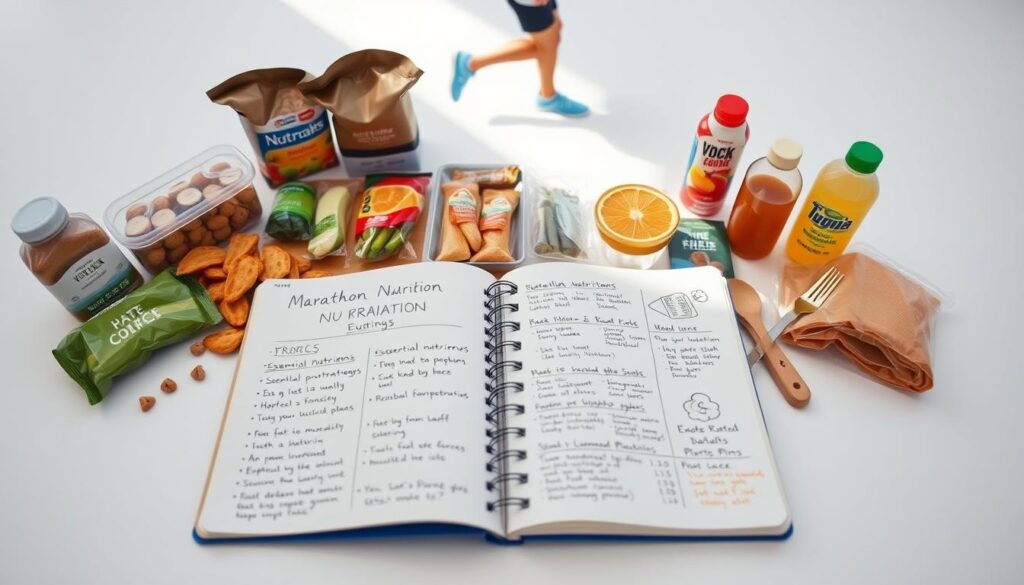
Imagine standing at the starting line, heart racing with excitement. This moment is within reach with the right preparation. A marathon is more than just 26.2 miles; it’s months of hard work.
Whether you’re new to marathons or have done them before, this guide has a marathon training plan for you. It’s like a roadmap to crossing that finish line without any shortcuts or regrets.
A personalized marathon training schedule is more than a list. It’s based on science, with 16 weeks of gradual progress. You’ll start with 10-mile runs and work up to 22-mile long runs.
Every step is important, from learning how to pace to knowing how to fuel. You’ll learn how to avoid injuries, pick the right shoes, and develop mental toughness.
Key Takeaways
- Most plans take 12-20 weeks, with 16 weeks as the gold standard for building endurance.
- Incorporate intervals, hills, and recovery runs to boost speed and resilience.
- Use 30g carbs every 30-45 minutes during long runs to fuel smart.
- Rest days and strength training (like squats) cut injury risk and improve performance.
- The Runna app (4.9⭐ on iOS, 4.7⭐ on Android) helps tailor your plan with real-time guidance.
Every runner’s journey is unique. This guide fits your pace, whether you’re aiming for 9:09/mile or faster. Let’s make your “someday dream” a step-by-step reality.
Understanding Marathon Training Fundamentals
A good marathon training plan makes dreams come true. Only 0.01% of people run marathons. Being well-prepared helps avoid injuries and ensures success on race day.
Why Proper Training Matters for Marathon Success
Top runners like Kenya’s Kelvin Kiptum didn’t ignore the basics. A solid beginner marathon training guide helps your body adjust. Skipping gradual increases in mileage can lead to injuries or hitting the wall.
TrainingPeaks suggests using heart rate data to monitor your progress safely.
Key Components of Effective Marathon Preparation
Every marathon training plan includes:
- Long runs that grow to 20–22 miles by week 8
- Speed work like 8×1-minute intervals at 5K pace
- Cross-training and rest days for recovery
Begin with 10-minute runs. Increase weekly mileage by no more than 10% to avoid injury.
Setting Realistic Marathon Goals Based on Your Experience
Beginners should aim for 50 miles/week in the final months. If you’re new, a 6-month plan builds endurance. For example, the Boston Marathon’s 3:10 qualifying pace is achievable with hard work.
Follow a 16-week plan if you’ve run half marathons. Track your progress weekly to stay on track.
Assessing Your Current Fitness Level
Before starting a long distance running program, it’s important to know your fitness level. Test your heart health, strength, and flexibility. Here’s how to do it:
- Cardio Check: Time yourself running 1.5 miles. For example, a 25-year-old woman aiming for under 13 minutes shows solid baseline fitness. Use a stopwatch or fitness app to track progress.
- Strength Test: Measure push-ups and squats. A 30-year-old man hitting 17-22 reps signals readiness for gradual training. Compare results to age-based benchmarks.
- Flexibility Screen: Perform a sit-and-reach test. If fingertips reach 28 cm or more, that’s “above average” flexibility. Note how far you stretch without bouncing.
- Heart Rate Monitoring: Calculate max heart rate (220 minus your age). For a 40-year-old, that’s 180 BPM). Aim for 50-70% of this during moderate workouts.

Record waist circumference and BMI. Women should stay under 35 inches, men under 40. A BMI between 18.5-24.9 aligns with optimal training conditions. Use these metrics to identify strengths and areas to improve. If you’re new to running, this process ensures you choose a beginner marathon training guide that matches your readiness. For instance, if your longest run is under 3 miles, start with a plan designed for novices. Track changes weekly to adjust your long distance running program safely. Honesty here prevents overtraining and sets a realistic path forward.
The 16-Week Marathon Training Plan for All Levels
Whether you’re new to running or aiming for a new record, this marathon training plan fits your goals. It’s spread over four months, mixing progress with rest to build endurance safely. Each stage is designed to match your level of experience.
Beginner Marathon Training Schedule
Begin with 20 miles a week. The first four weeks focus on regular runs: two easy 3-mile runs, one 5-mile run, and an 8-mile long run. Rest and cross-training days help keep stress down. By week 8, long runs reach 12 miles, with easy runs increasing slowly.
Intermediate Runner Training Calendar
Intermediate plans increase weekly miles from 35 to 48. You’ll do tempo runs at 80% effort and hill repeats to build stamina. The peak week includes a 20-mile long run, three weeks before the race, keeping 80% of runs at a conversational marathon training plan pace.
Advanced Marathon Training Program
For experienced runners, the advanced marathon training plan includes 52-56 miles a week with speedwork. You’ll do intervals at goal pace, 12-mile tempo runs, and long runs at marathon pace. TrainingPeaks helps track your progress in real-time.
Adapting Your Plan for Race Conditions
“Adjusting your training to race conditions is key to success.”
- Heat/Hills: Add 1-2 hot-weather or incline sessions monthly.
- Altitude:
- Taper:
Start high-intensity workouts 4 weeks pre-race to acclimate.
Reduce volume by 20-30% in final three weeks while maintaining quality.

Every runner’s journey is unique. Use the PDF or TrainingPeaks templates to adjust your plan. Focus on consistency over speed—progress builds week by week. Stay flexible and listen to your body to avoid overtraining.
Building Endurance: Long Run Strategies
Long runs are key for marathon training for endurance. They teach your body to keep going. A long distance running program needs balance to avoid burnout. Coach Jack Daniels said, “Long runs build mental toughness and prepare you for race-day demands.”
“The secret to endurance is consistency, not intensity.” — Jack Daniels, renowned running coach
Begin with short, steady runs. Follow these steps:
- Progressive Mileage: Add 1–2 miles to your long runs each week. Don’t go over a 10% weekly increase. For example, start with 8 miles and go up to 20 miles.
- Pace Strategy: Run 20–33% slower than your 10K pace. If you run a 7:00/mile 10K, aim for 8:20–9:30/mile in long runs.
- Mental Anchors: Break runs into parts (like “just to the next mile marker”). Use mantras like “one step at a time” to stay focused.

- Drink water within 30 minutes after running. Eat a 4:1 carb-to-protein snack.
- Take walk breaks every 30 minutes if needed. Studies show this boosts endurance without losing progress.
- Plan cutback weeks every 4 weeks. Reduce mileage by 30% to let your body adapt.
Use strength training and anti-chafing products too. Remember, being consistent and patient helps you get ready for the race.
Speed Work and Strength Training for Marathon Runners
Add speed work to your marathon training plan to get ready for the race. Do tempo runs, hill repeats, and interval sessions. These improve your running by making you more efficient.
For example, 800-meter repeats at your goal pace help your body and mind work better together.

“Strength training reduces injury risk by 30% while improving running economy by 8%.”
Here’s a plan for strength training:
- Lower body focus: squats, lunges, calf raises
- Core exercises: planks, Russian twists
- Upper body: push-ups, rows
| Phase | Weeks | Focus |
|---|---|---|
| Skill Development | 1-5 | Bodyweight exercises, 2x weekly sessions |
| Maximal Strength | 6-10 | Barbell squats (3×6 reps), 3×5 in final weeks) |
| Explosive | 11-14 | Plyometrics like box jumps |
| Taper | 15-16 | 50% volume maintenance |
Follow the advanced marathon training plan for 2 weekly sessions. Make sure to rest for 48 hours between them. The MOTTIV app has mobility routines to help with injury prevention.
Studies show this plan can make you run better. It’s based on science from the Journal of Sports Biomechanics (2019). DOI:10.1080/02640414.2018.154527). Study 2: 2018 injury reduction study).
Stick to the plan for 16 weeks. It will help you stay strong at the end of the race. Remember to rest on recovery days to stay safe.
Nutrition and Hydration Throughout Your Marathon Prep Schedule
Proper fuel and fluids are key to your marathon prep schedule. Every runner’s body is different. So, your personalized marathon training schedule should include nutrition plans tested before race day.

Pre-Run Fueling Strategies
Start each workout with 30-50% carbs. Women might need a 2:1 carb-to protein ratio. Men can aim for 4:1. Try a banana with peanut butter (300 calories) 2-3 hours before long runs.
For shorter runs, a small snack like a granola bar 30 minutes pre-run keeps energy steady.
Mid-Run Nutrition and Hydration
During runs over 60 minutes, aim for 30-70g carbs/hour. Mix sources like a gel (25g), energy bar (40g), and a banana (27g) to avoid GI upset. Follow ACSM guidelines: drink 5-12 oz fluids every 15-20 minutes. Add electrolytes if training over 2 hours.
Post-Run Recovery Foods
Replenish with 20-30g protein within 30 minutes post-run. Greek yogurt with berries or a turkey wrap pairs well with carbs like rice cakes. Women should prioritize protein-rich meals to match their higher glycogen needs.
Creating Your Personalized Marathon Training Schedule
Test carbs like chews (16-25g) or jelly beans (11g) during training runs. Track how your body handles caffeine (aim for 3mg/kg body weight via gels or espresso). Adjust hydration based on urine color: pale yellow means hydrated, dark yellow signals dehydration. Adjust your personalized marathon training schedule weekly as your body adapts.
Essential Gear for Successful Marathon Training
Your marathon training plan gets better with the right gear. Start with shoes. Choose ones like the Brooks Hyperion 2 ($140) or Adidas Adizero Adios Pro 4 ($250). They should fit your foot type and how much you run.
Change them every 300-500 miles. Wear different pairs for long runs to make them last longer.

- Clothing: Wear clothes that wick away moisture. Try Lululemon’s 5″ Pace Breaker Shorts ($68) or merino wool tops from Ibex. Stay away from cotton to avoid chafing.
- Technology: Use a GPS watch like Garmin. Or try Shokz OpenRun Pro 2 headphones ($180) for 12 hours of music.
- Recovery: Use a foam roller or massage gun for muscle recovery. Don’t forget sunscreen, even on cloudy days, to protect your skin during long runs.
Choose lightweight gear. Arc’teryx Norvan 7 vests ($160) or Salomon Adv Skin packs are good. Pick brands like Nike Vaporfly or New Balance for better performance. Try energy gels like Gu or Honey Stinger during training to avoid surprises on race day.
Remember safety first. Use anti-chafe lubricant, reflective gear for evening runs, and safety pins. Your marathon prep schedule will be better. Quality gear helps, but don’t forget to stay consistent with your training.
Avoiding Common Marathon Training Injuries
Every year, thousands of runners face setbacks due to injuries. A study of 720 first-time marathoners found nearly half suffered minor injuries during training. Overuse was the top cause. This section of the beginner marathon training guide explains how to stay safe while building endurance for race day.

Recognizing Warning Signs Before They Become Injuries
Sharp pain that worsens with activity isn’t normal. Watch for persistent aches in knees or feet—common injury hotspots. Sudden performance drops, like slower paces during easy runs, signal overtraining.
If you feel compensating movements like limping, pause your routine immediately.
Prevention Techniques for Marathon Runners
- Warm up 10-15 minutes with dynamic stretches before runs
- Incorporate yoga or swimming for cross-training
- Replace shoes after 300 miles
- Stick to a 10% weekly mileage increase
- Track cadence: Aim for 150-160 steps per minute
Rest 1-2 days weekly to let muscles rebuild. The marathon training for endurance requires balancing effort with recovery.
When to Rest vs. When to Push Through
Listen to your body. Rest days are mandatory if you feel:
- Sharp pain during activity
- Swelling or bruising
- Numbness or tingling
Minor muscle soreness after tough runs is normal. If pain disappears by the next run, ease back gradually. If it persists, consult a sports medicine specialist.
Conclusion: Taking Your Marathon Success Beyond the Finish Line
Finishing a marathon is a huge win. But the skills you’ve gained go way beyond race day. Every mile has made you stronger, more disciplined, and connected to your body.
These skills help you face life’s big challenges. They’re not just for running.
After the race, recovery is key. Drink lots of water, eat foods rich in nutrients, and rest well. Use what you learned during long runs to recover fully.
Even after you finish, your journey doesn’t stop. Many runners set new goals, like running faster or trying ultramarathons. They also use their training skills in work or personal projects.
Success comes from being consistent and having a community. Running with friends or using social media for support helps a lot. Studies show a 95% success rate with training buddies.
Keep your plan flexible, whether you’re aiming for the Boston Marathon or a local race. The mental strength and pacing skills you’ve learned help in any challenge that requires endurance.
Your marathon is just the beginning. It shows what hard work can do. Celebrate your achievements and use that drive for new goals. The finish line is just the start of your story.















